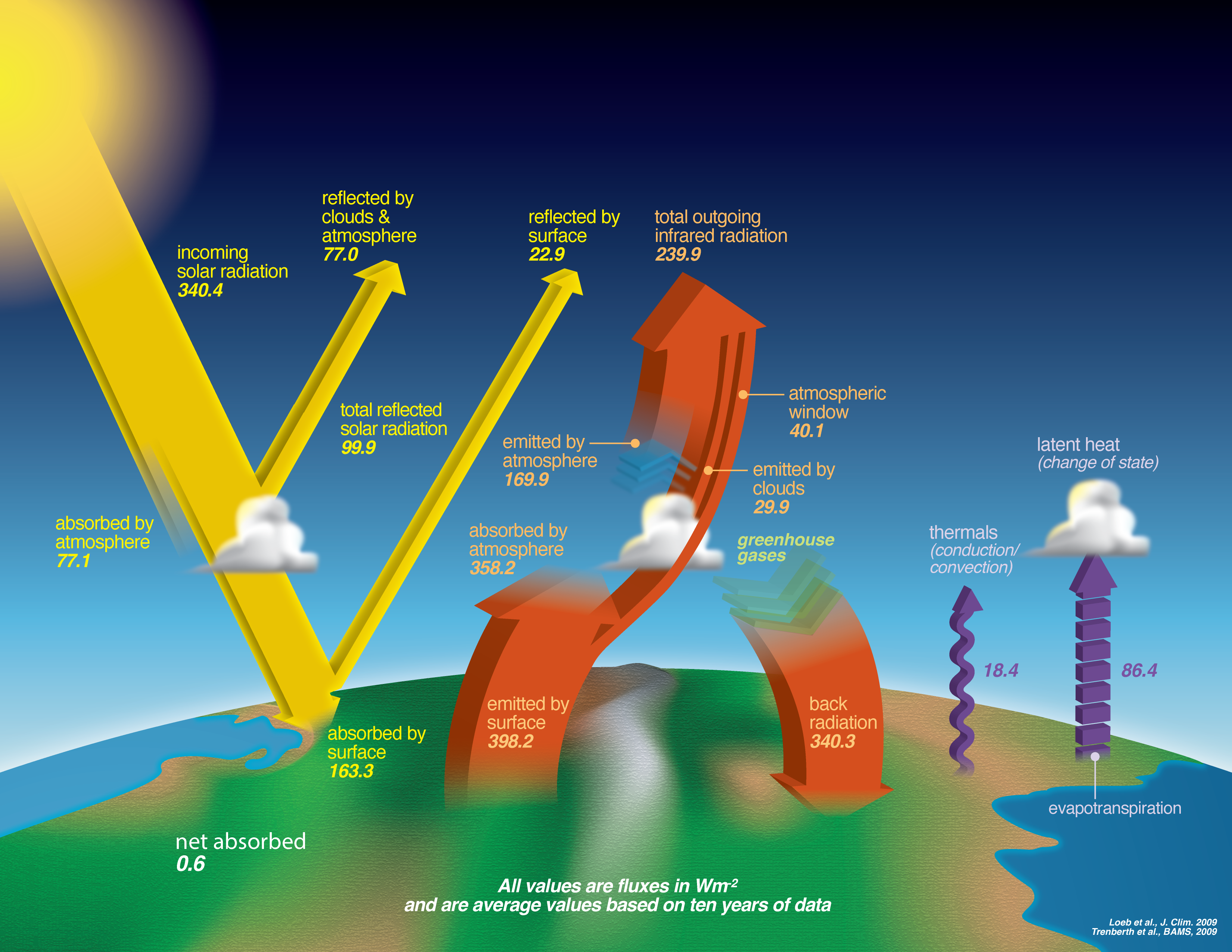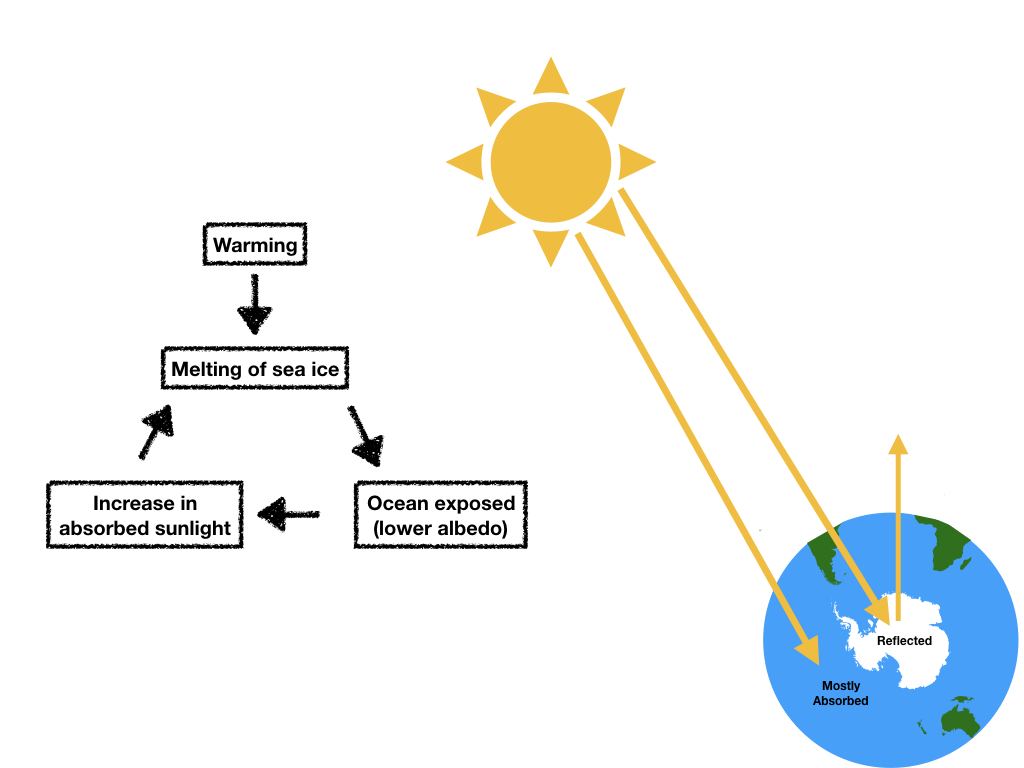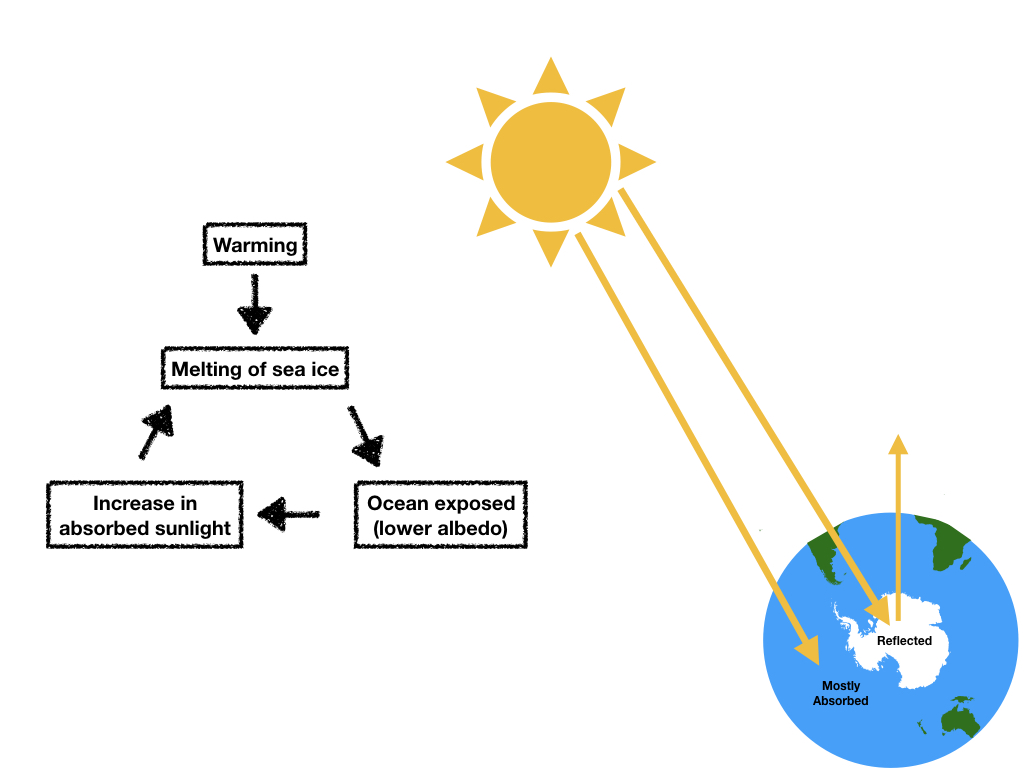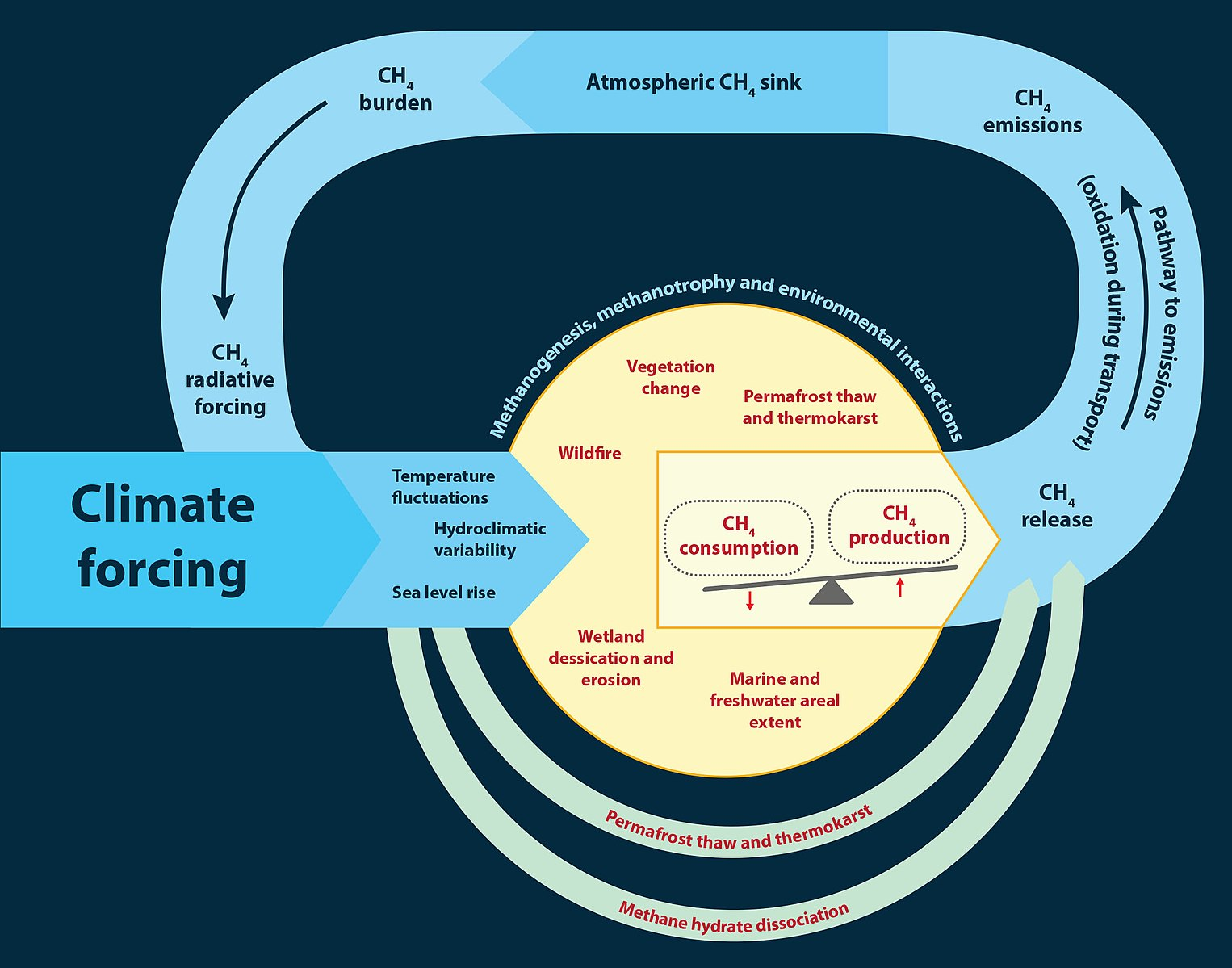IB Syllabus focus:
‘Systems diagrams capture solar variability, albedo changes, methane releases and feedback loops (positive/negative) that modify Earth’s energy balance.’
Earth’s climate system is dynamic, shaped by complex interactions between energy inputs, feedback loops, and surface processes. Understanding feedbacks and energy-balance models is central to evaluating climate change.
Earth’s Energy Balance
The Earth’s climate is governed by a delicate balance between incoming shortwave solar radiation and outgoing longwave infrared radiation. Any disruption to this balance affects global temperature and climate stability.

Simplified diagram of Earth’s energy budget showing incoming solar radiation, reflected shortwave, and emitted longwave components that together determine net radiative balance. Labels highlight how reflection, absorption, and re-emission partition energy flows in the climate system. Use this to anchor discussion of radiative forcing and modelled imbalances. Source.
Incoming solar radiation: Mainly visible and shortwave radiation from the Sun.
Reflected radiation: Some energy is reflected back into space by surfaces like ice, clouds, and deserts.
Absorbed energy: The rest is absorbed by the atmosphere, land, and oceans, warming the planet.
Outgoing infrared radiation: The Earth re-emits energy as longwave radiation, partially absorbed and re-radiated by greenhouse gases.
Definition of Key Terms
Albedo: The fraction of solar energy reflected by a surface. High-albedo surfaces like ice reflect more radiation, cooling the planet.
Between absorbed and reflected energy, small changes in surface properties can alter Earth’s radiative balance significantly.
Feedback Mechanisms
Feedbacks are processes that either amplify or dampen changes in the climate system. They are critical for understanding both natural variability and anthropogenic climate change.
Positive Feedbacks
Positive feedbacks amplify initial changes, leading to greater warming or cooling.
Ice–albedo feedback:
Rising temperatures melt ice.
Less ice reduces albedo.
More energy is absorbed, causing further warming.

A concise schematic of the ice–albedo feedback: warming reduces ice cover, lowers surface albedo, increases absorbed solar energy, and promotes further warming. The closed-loop arrows emphasise reinforcement characteristic of positive feedbacks in energy-balance models. Labels are minimal and aligned with IB ESS scope. Source.
Methane release from permafrost:
Warming melts permafrost.
Methane (a potent GHG) is released.
Increased methane intensifies greenhouse warming.
Water vapour feedback:
Warming increases evaporation.
More water vapour enhances the greenhouse effect.
Further warming occurs.
Negative Feedbacks
Negative feedbacks counteract changes, providing climate stability.
Cloud formation:
Higher temperatures increase evaporation.
More clouds may form, reflecting solar radiation.
This reduces surface warming.
Increased plant growth (carbon sink):
Higher CO₂ stimulates photosynthesis.
Plants absorb more CO₂, reducing atmospheric concentration.
This moderates warming.
Solar Variability
The Sun’s output is not constant; it varies over time due to solar cycles.
Solar Variability: Natural fluctuations in solar radiation caused by processes such as sunspot cycles.
Small changes in solar energy input can influence Earth’s energy balance, though recent warming trends are primarily driven by anthropogenic greenhouse gases.
Albedo Changes
Albedo shifts directly affect Earth’s ability to reflect solar radiation.

A concise schematic of the ice–albedo feedback: warming reduces ice cover, lowers surface albedo, increases absorbed solar energy, and promotes further warming. The closed-loop arrows emphasise reinforcement characteristic of positive feedbacks in energy-balance models. Labels are minimal and aligned with IB ESS scope. Source.
High albedo surfaces (ice, snow, deserts) reflect energy, promoting cooling.
Low albedo surfaces (forests, oceans) absorb more energy, promoting warming.
Climate change drives large-scale albedo shifts, such as Arctic sea ice decline.
Methane Release
Methane is a powerful greenhouse gas, around 25 times more effective than CO₂ over a century.

Diagram linking permafrost and ecosystem methane emissions to atmospheric CH₄, radiative forcing, and reinforced warming—an example of a positive feedback loop. Extra detail on oxidation and atmospheric sinks is included for completeness but not required by the syllabus. Use selectively to illustrate feedback placement within energy-balance thinking. Source.
Released naturally from wetlands and livestock.
Large stores exist in permafrost and ocean clathrates.
Warming accelerates release, strengthening the enhanced greenhouse effect.
Energy-Balance Models
Scientists use energy-balance models to simplify and study climate system dynamics. These models evaluate how inputs and outputs of energy interact under different scenarios.
Inputs: Solar radiation, human GHG emissions, aerosols.
Outputs: Longwave infrared radiation, reflected shortwave radiation.
Feedback loops: Incorporated to show amplification or stabilisation effects.
Energy Balance (ΔE) = Incoming Energy – Outgoing Energy
ΔE = Net change in Earth’s stored energy (measured in W/m²).
When ΔE ≠ 0, Earth’s climate adjusts, leading to warming (positive imbalance) or cooling (negative imbalance).
Feedback Loops in Energy-Balance Models
Energy-balance models include feedbacks to project future climate trajectories.
Positive feedback loops: Strengthen the effect of initial forcing, often creating non-linear responses (e.g., sudden permafrost methane release).
Negative feedback loops: Stabilise the system, slowing the rate of change (e.g., cloud reflectivity).
These feedback loops highlight why climate projections carry uncertainties—small changes can trigger disproportionately large impacts.
Linking Feedbacks to Climate Change
The ice–albedo feedback accelerates Arctic warming, affecting global circulation.
Methane releases risk crossing tipping points in climate systems.
Cloud and vegetation responses provide some negative feedbacks but are often overwhelmed by stronger positive processes.
The balance of these feedbacks determines whether Earth’s energy system trends toward stability or rapid change.
Energy-balance models capture these interactions, providing policymakers with insight into potential futures under varying emission scenarios.
FAQ
Short-term feedbacks act quickly and can be observed within years or decades, such as changes in water vapour or cloud cover.
Long-term feedbacks operate over centuries or millennia, including processes like ice sheet loss or methane release from deep permafrost. These tend to lock the climate into new states and are harder to reverse.
Feedback strength is assessed using climate sensitivity parameters, which indicate how much the global temperature changes for a given forcing.
A positive value suggests the feedback amplifies warming.
A negative value indicates stabilisation or cooling effects.
Models simulate different scenarios and compare outcomes to real-world observations to refine these values.
Methane is over 25 times more effective at trapping heat than CO₂ over a century.
Large methane stores in permafrost and ocean clathrates can be released suddenly, creating rapid surges in radiative forcing. This makes methane-driven feedbacks a potential tipping point for global climate.
Uncertainty is built in by running multiple simulations with varied assumptions about feedback strength and timing.
Ensemble modelling compares these runs to generate probability ranges. This helps highlight best- and worst-case scenarios, rather than single outcomes.
Clouds can cool the planet by reflecting sunlight (negative feedback) but also warm it by trapping infrared radiation (positive feedback).
The net effect depends on:
Cloud altitude (high thin clouds often warm, low thick clouds often cool).
Cloud distribution and thickness.
Regional differences in atmospheric conditions.
Practice Questions
Define the term albedo and explain how changes in albedo can influence Earth’s energy balance.
Mark scheme:
1 mark for correctly defining albedo: the proportion of solar energy reflected by a surface.
1 mark for linking albedo changes to energy balance (e.g., lower albedo increases absorption and warming, higher albedo increases reflection and cooling).
Question 2 (5 marks)
Discuss how positive and negative feedback mechanisms affect Earth’s energy balance, using one example of each.
Mark scheme:
1 mark for identifying what a feedback mechanism is (a process that either amplifies or counteracts change).
1 mark for describing positive feedback (amplifies change).
1 mark for giving a correct example of positive feedback (e.g., ice–albedo loop, methane release from permafrost).
1 mark for describing negative feedback (counteracts change).
1 mark for giving a correct example of negative feedback (e.g., cloud formation reflecting solar radiation, increased plant growth absorbing CO₂).

